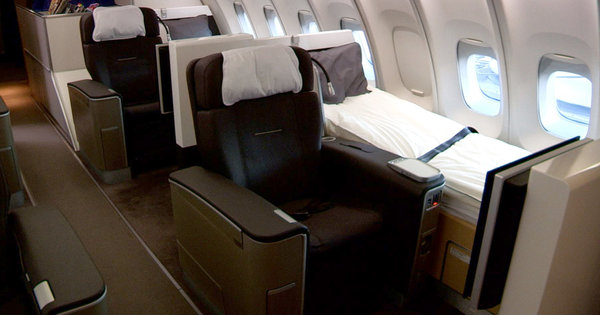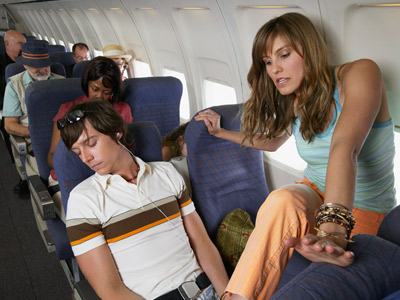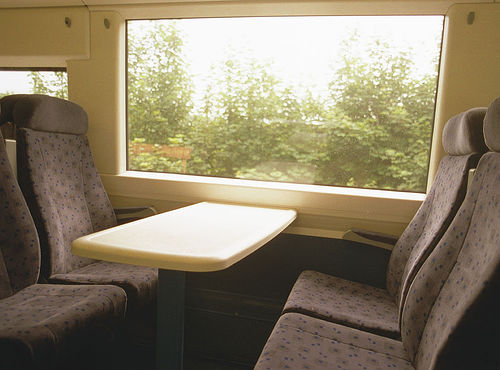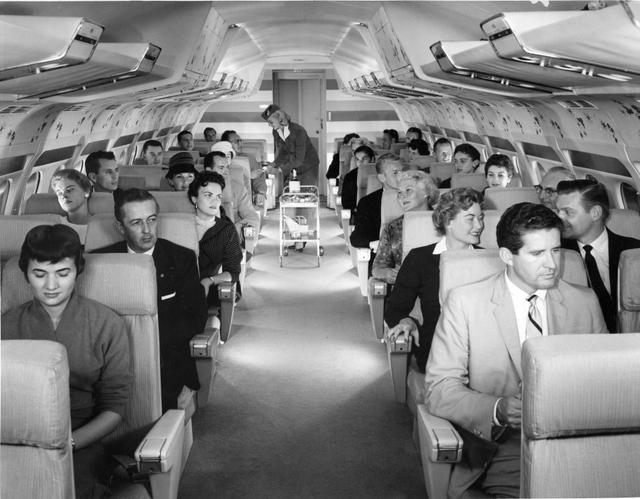Taking First-Class Coddling Above and Beyond
The gap between first class and coach has never been so wide.
By Jad Mouawad New York Times November 20, 2011
Carriers on international flights are offering private suites for first-class passengers, three-star meals and personal service once found only on corporate jets. They provide massages before takeoff, whisk passengers through special customs lanes and drive them in a private limousine right to the plane. Some have bars. One airline has installed showers onboard.
The amenities in the back of the cabin? Sparse.
So as domestic travelers take to the skies for the holiday season, most will be in cramped cabins, their food is likely to be bland and they will have paid for it, along with any fees for slightly more legroom or checked bags.
But even as they have cut back on domestic service, including first-class accommodations, the airlines have been engaged in a global battle for top executives and the superwealthy on their international routes. Though only a privileged few can afford to pay $15,000 to fly first class from New York to Singapore or Sydney, the airlines are betting that the image of luxury they project for the front helps attract passengers to the rest of the plane. That includes a growing business-class section with offerings once solely the preserve of first class.
Though first class represents less than 5 percent of all seats flown on long-haul routes, and business class accounts for 15 percent, those seats combined to generate 40 to 50 percent of airlines’ revenue, according to Peter Morris, the chief economist at Ascend, an aviation consulting firm.
As a general rule, business class is five to 10 times the price of an economy ticket, while first class is usually twice the price of business. “First class,” said Brett Snyder, president of Cranky Concierge, an air travel assistance Web site, “is status.”
Until the 1980s, first class was roomier than coach, but not all that fancy. The seats in the front offered more legroom but did not recline more than 40 degrees. The food was better in first class too, though even the meals in coach were better than they are now. With globalization, particularly the rise of Asia, passengers began demanding more from first class, especially with new planes that could fly much longer routes without stopping.
Airlines have expanded their focus — which had been limited to London, Paris, and New York — to emerging economic centers like Hong Kong, Shanghai and Dubai. “Obviously the first-class passenger is a very senior person in his company, coming a long way around the world, and probably doing something very important for his business,” said John Slosar, the chief executive of Cathay Pacific Airways. “He requires to be able to sleep, work on his speech, perhaps take a shower upon arrival, so he can hit the ground running.”
British Airways was among the first airlines to change the definition of what first class entailed by offering flat-bed seats in the 1990s on its long-haul routes.
In recent years, the airlines most aggressive in adding luxury touches to first class have come from Asia and the Middle East, among them Cathay Pacific and Singapore Airlines. Emirates, based in Dubai, came up with personal suites for first-class passengers in 2003 and in 2008 installed two showers on its Airbus A380 planes for them.
European airlines quickly recognized the threat. Air France, for instance, now has a dedicated first-class lounge in Paris with a spa and a restaurant catered by the chef Alain Ducasse. Immigration officers come directly into the lounge to check passports, and passengers are driven to the airplane in a limousine only seconds before the doors shut.
But American carriers were slower to react, largely because they lacked the funds to upgrade their cabins until recently. Now, they have little choice. International rivals are starting to encroach deeper into their domestic markets, beyond New York and Los Angeles. Emirates, for instance, announced it would begin service from Dubai to Dallas and Seattle early next year.
“If you don’t refurbish your cabins, then all you are left with is the low-yielding traffic,” Mr. Morris said. “It’s just not an option.” First class has also served as a lab for in-flight amenities that eventually trickled down to the rest of the plane. Individual screens are now found in the seatbacks in coach. Lie-flat seats have moved to business class.
In fact, business class has become so comfortable that, in many cases, it can rival first class itself. “People demand more from the business class than they used to,” Mr. Snyder said.
That is why some airlines have concluded that the market for first-class passengers is too slim to justify the investments, especially since passengers sitting in the front seats are often upgraded from business class or got their tickets using airline miles.
“A plane is only so big,” said Jim Compton, the chief revenue officer at United Continental Holdings. “And the reality is that demand for the product in all markets is not necessarily there.”
After its merger with Continental last year, United Airlines kept its first-class cabin only on some international routes that used to be served by United but not on those flown by Continental. It is also installing new flat-bed seats across its fleet in business class.
Delta Air Lines and Qatar Airways, by contrast, do not have a first class, just business and coach. Others have reduced the number of seats in first class. Air France now flies planes with first-class seats to only 28 international cities, out of a network of over 250 destinations.
Lufthansa, for its part, has kept its first class on most flights but has removed half the seats to focus on a more intimate experience on board. In the new A380 aircraft, Lufthansa also installed a system that increases the humidity in the first-class cabin by 25 percent, which the airline says will help ease jetlag. It has also insulated the cabin with special soundproofing material.
“It is our premium product, and our customers were asking for more intimacy, more privacy,” said Jürgen Siebenrock, Lufthansa’s vice president for North and South America. “If you want to be competitive, you really need to upgrade your product.”
Nothing compares with the experience of flying first class, said Geoffrey Fischer, a 33-year-old social media consultant based in Seattle. Even after his 15-hour flight on Cathay Pacific landed in Hong Kong, he did not want to get off the plane, he said. Throughout the trip, which he also wrote about on the Cranky Flier blog, he was plied with Champagne and wine. He was served caviar as an appetizer on fine bone china and with a linen tablecloth. His seat turned into a full-size bed. He was handed designer pajamas to wear while an attentive flight attendant made up his bed, complete with a pillow, duvet and sheets.
“I’ve never experienced such a private jet atmosphere,” said Mr. Fischer, who snagged his seat using frequent flier miles. “It was the best flight I’ve ever been on.”
New York and Chicago Railroad
Transportation Equity
Airlines Regard Coach Passengers as "low-yielding traffic"
"Though first class represents less than 5 percent of all seats flown on long-haul routes, and business class accounts for 15 percent, those seats combined to generate 40 to 50 percent of airlines’ revenue"





